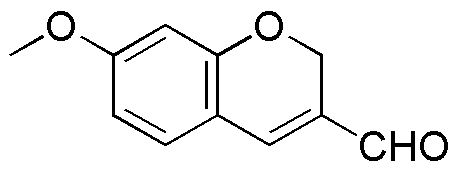7-Methoxy-2H-chromene-3-carbaldehyde is widely utilized in research focused on:
- Pharmaceutical Development: This compound serves as a valuable intermediate in the synthesis of various pharmaceuticals, particularly those targeting neurological disorders, due to its unique chemical structure that can interact with biological systems effectively.
- Natural Product Synthesis: It is used in the synthesis of natural products, allowing researchers to create compounds that mimic the properties of naturally occurring substances, which can lead to new therapeutic agents.
- Fluorescent Probes: The compound can be modified to develop fluorescent probes for biological imaging, enhancing the ability to visualize cellular processes in real-time, which is crucial for research in cell biology.
- Material Science: It finds applications in the development of advanced materials, such as organic light-emitting diodes (OLEDs), due to its photophysical properties, contributing to the electronics industry.
- Food Industry: This chemical is explored for its potential as a flavoring agent or preservative, leveraging its aromatic properties to enhance food products while ensuring safety and quality.
General Information
Properties
Safety and Regulations
Applications
7-Methoxy-2H-chromene-3-carbaldehyde is widely utilized in research focused on:
- Pharmaceutical Development: This compound serves as a valuable intermediate in the synthesis of various pharmaceuticals, particularly those targeting neurological disorders, due to its unique chemical structure that can interact with biological systems effectively.
- Natural Product Synthesis: It is used in the synthesis of natural products, allowing researchers to create compounds that mimic the properties of naturally occurring substances, which can lead to new therapeutic agents.
- Fluorescent Probes: The compound can be modified to develop fluorescent probes for biological imaging, enhancing the ability to visualize cellular processes in real-time, which is crucial for research in cell biology.
- Material Science: It finds applications in the development of advanced materials, such as organic light-emitting diodes (OLEDs), due to its photophysical properties, contributing to the electronics industry.
- Food Industry: This chemical is explored for its potential as a flavoring agent or preservative, leveraging its aromatic properties to enhance food products while ensuring safety and quality.
Documents
Safety Data Sheets (SDS)
The SDS provides comprehensive safety information on handling, storage, and disposal of the product.
Product Specification (PS)
The PS provides a comprehensive breakdown of the product’s properties, including chemical composition, physical state, purity, and storage requirements. It also details acceptable quality ranges and the product's intended applications.
Certificates of Analysis (COA)
Search for Certificates of Analysis (COA) by entering the products Lot Number. Lot and Batch Numbers can be found on a product’s label following the words ‘Lot’ or ‘Batch’.
*Catalog Number
*Lot Number
Certificates Of Origin (COO)
This COO confirms the country where the product was manufactured, and also details the materials and components used in it and whether it is derived from natural, synthetic, or other specific sources. This certificate may be required for customs, trade, and regulatory compliance.
*Catalog Number
*Lot Number
Safety Data Sheets (SDS)
The SDS provides comprehensive safety information on handling, storage, and disposal of the product.
DownloadProduct Specification (PS)
The PS provides a comprehensive breakdown of the product’s properties, including chemical composition, physical state, purity, and storage requirements. It also details acceptable quality ranges and the product's intended applications.
DownloadCertificates of Analysis (COA)
Search for Certificates of Analysis (COA) by entering the products Lot Number. Lot and Batch Numbers can be found on a product’s label following the words ‘Lot’ or ‘Batch’.
*Catalog Number
*Lot Number
Certificates Of Origin (COO)
This COO confirms the country where the product was manufactured, and also details the materials and components used in it and whether it is derived from natural, synthetic, or other specific sources. This certificate may be required for customs, trade, and regulatory compliance.

